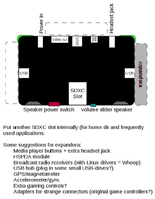While expandora modules would be more expensive than mass-produced equivalents, Those really don't cut it as expansion modules. Drivers are problematic and they don't fit in your pocket
Some (e.g. original controller adapters, Broadcast radio receivers) would add useful functionality to a Pandora unavailable comercially. retrodes are big (especially if you have already ripped games), Linux compatible radio receivers are non-existent.
Sure, I understand, but if I look at the features you propose:
- media player buttons + extra headset jack
One headset is enough for me, it would make more sense to support those remote controls integrated into headsets.
- HSDPA module, GPS
Easier to connect these over bluetooth instead
- adapters for game controllers
this is not a mobile scenario, I see no real benefit over a regular USB hub + adapter
- Broadcast radio receiver
Personally, I have zero use for this
The one extension which does make sense to me would be a single compact T-piece which plugs into the back and provides:
L2+R2, Accelerometers (No need for a gyro, you're not going to swing around a device which you need to look at), optionally a 1 or 2 ports USB-hub.
If somebody would make such a thing, it would already work with the current design without needing any further hardware modifications. Furthermore, the current design can not fit both a USB1.0/1.1 and USB 2.0 controller for the full-sized USB port, I doubt you can suddenly fit three USB controllers.
Another argument against the sideways USB-ports is that they widen the unit.
They would make it quite a bit harder (i.e. uncomfortable) to reach the middle buttons.
Carrying around multiple of these extension pieces would prevent me from putting all the extras into the pockets of my jackets,
which means that on many occasions I would not take them with me anyway.
So to conclude, I don't really care enough about most of those extensions to become enthusiastic about your proposal, not does the current design prevent creation of such additions. Whatever is preventing them from being made now will not disappear by adding two extra ports on the side.


